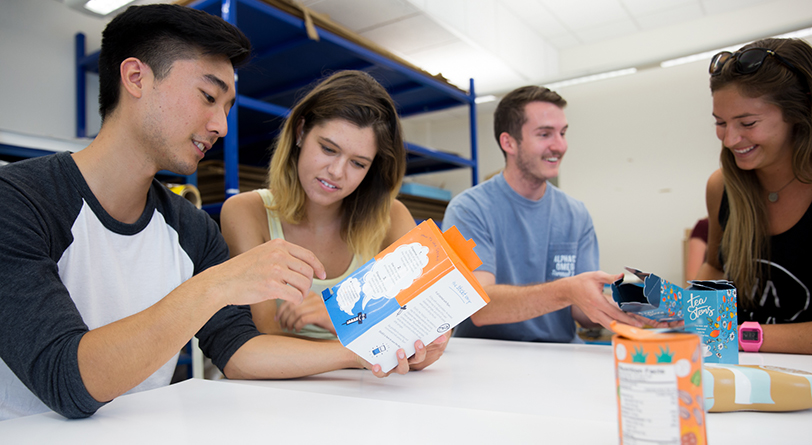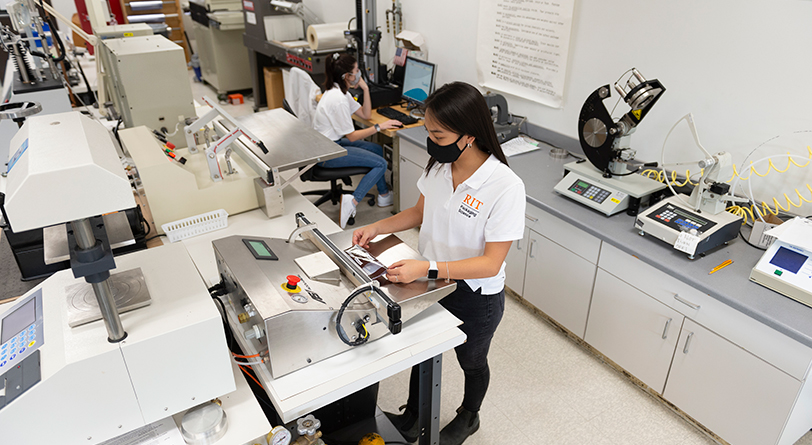Dwight Schmidt has spent decades in the paper packaging industry, accumulating knowledge and connections that have included being on the industry advisory board for the Michigan State University (MSU) School of Packaging.
About six years ago, Michigan State asked him to help find a new packaging program director, which led him to Matthew Daum, Ph.D., an acquaintance who eventually got the top job. Daum then asked Schmidt to join a team to help Daum fine-tune the university’s packaging program.
“He wanted us to help him take a new look at the curriculum and find any gaps that they might have,” recalls Schmidt, who has a packaging degree from Michigan and is a member of the school’s Packaging Hall of Fame. He was named consultant emeritus at the MSU School of Packaging.

Schmidt, who founded Consult Schmidt LLC in 2002, started work with a small team to develop a benchmarking survey.
“From my years in the packaging industry, I knew all of the directors of the other programs that have four-year degrees,” Schmidt says. “I contacted them to say, ‘I have put together a benchmarking survey, and we will give you everyone’s results in exchange for your information.’”
The initial survey included everything from the number of students to the number of graduates to the number of faculty and other program details.
“Everyone was interested in doing more than just exchanging that information,” Schmidt says. “So, we put together several documents regarding each school, comparing their strengths, weaknesses, threats, and opportunities.
“One of the things we discovered is that everyone had an issue or a weakness that they were struggling with. But not all people were struggling with the same weaknesses, so I suggested that we get together on an informal basis and start talking about all of this.”
Packaging Program Council Is Born
That suggestion led to the formation of the Packaging Program Council (PPC) in 2020. Schmidt and his team had completed a gap analysis for Michigan State’s packaging program and started working to change the school’s curriculum.
PPC’s goal was to extend that type of knowledge to the other packaging schools in the U.S., with additional input from trade groups such as the Institute of Packaging Professionals (IoPP); PMMI, The Association for Packaging and Processing Technologies; International Safe Transit Association (ISTA); and Trayak, Inc., which develops life cycle assessment tools. Through requests for proposals, the International Corrugated Packaging Foundation has donated more than $10 million and curriculum to these and other programs to ensure graduates are aware of careers in its industry, Schmidt adds.
PMMI became involved because it builds partnerships with schools, technical training programs, and organizations across the manufacturing supply chain in the packaging and processing industry. One of PMMI’s goals is to help connect employers with emerging talent, says Kate Fiorianti, PMMI’s director of workforce development.
“A key part of this strategy is our involvement with the Packaging Program Council,” Fiorianti says. “PMMI’s involvement helps bridge the gap between academia and industry by fostering connections that strengthen curriculum; enhance program relevance; and create valuable networking opportunities for faculty, students, and industry leaders alike.”
PPC’s platform helps ensure educational programs align with real-world industry needs, she adds.
PPC meets about every quarter for roughly 90 minutes online and occasionally in person such as at PACK EXPO International in Chicago where the meetings might run several hours. By early this year, the council had met 17 times and had established in-depth reports.
The conversations and reports are intended to exchange information “to raise all ships,” Schmidt says.
Core Membership
PPC decided to limit its core membership to the nine institutions granting four-year packaging degrees in the U.S. While other schools offer courses or training in packaging, the council needed to focus its efforts.
“We decided to limit it to just those that offer four-year packaging degrees,” he says. “They can be from anywhere, but they must offer a four-year packaging degree.”
That focus has helped PPC create a central depository of the curriculum information from those nine schools.
“We’ve done a lot of work over the years, and we’re to that point where we’re quite mature,” Schmidt says. As turnover happens at the higher education institutions, newcomers can catch up. “I put together a summary of all 17 meetings so they could go back and say, ‘Oh, you’ve already covered this topic, but I want to hear more about it.’”
For instance, guidance is offered on which universities have advisory boards and who runs them, along with the expectations for a board’s participants. It also allows them to exchange information about faculty salaries and tenure, graduation requirements for students, curriculum details, how to connect faculty with publications so they can publish articles, and any other information required to put together an effective degree program.

“It’s a number of smaller details like that and what everybody struggles with, so we get together and share the information,” Schmidt says.
That is where the work with the various trade associations also comes in. “We all know somebody at the associations, and we all do different things with them,” he explains. “But maybe they’re doing something for you that I’d like to have done here and vice versa.”
At meetings held online, representatives of trade groups are invited to participate and foster an ongoing dialogue, Schmidt says.
During PACK EXPO International in 2022, PMMI offered a room for PPC to meet in person, says Joe Angel, PMMI’s executive vice president of industry outreach. He presented an overview of PMMI and its educational efforts, including PMMI’s Skills Fund for Future Workforce. The fund is available to PMMI members to help support educational efforts. PPC held another meeting during PACK EXPO Inter-national in 2024.
“PMMI is ready and willing to continue supporting PPC for future events,” Angel says.
Another example is that IoPP has programs for recruiting people into the industry. Others might offer grants, so that information could be important to all PPC members.
“ISTA does undergraduate research grants,” Schmidt says. “This allows students to focus on solving a specific distribution packaging problem of their choosing. There’s just a lot of value there.”
As another example, students need Trayak’s life cycle assessment software to design sustainable packaging. The discussions have included how the schools use the software, how they obtain their licenses, and at what cost.
The benefits can go both ways, Schmidt adds. Some associations such as IoPP have chapters, so PPC can help some chapters become more active, he says.
Recruiting
This all comes at a time when schools must do more to increase student interest in packaging degrees. Historically, Schmidt notes, packaging has been a transfer major for many students.
“Very few incoming freshmen are walking around campus saying, ‘I’m going to go to school for packaging,’” he says.
For example, students might start in a curriculum for mechanical engineering and decide they don’t want to pursue that discipline. “They then see someone who has adopted packaging and see that packaging is more applied engineering. They are still in an engineering STEM discipline, but they get a chance to be more creative and quickly see the results of their labor.”
When packaging schools have recruitment days, corporations eagerly participate to find students because the demand for talent is much larger than the supply.

“From that perspective, the grads are gobbled up at really good salaries,” Schmidt says. “Whether it is Michigan State or Clemson or Cal-Poly, the schools can say this is where students get to work on sustainability. They get to be creative. They get to have a job when they come out at a high salary.
“And the packaging industry itself is a family, and I don’t think people understand that,” he adds. At MSU alone, he says, thousands of alums are willing to mentor people interested in advancing their packaging careers.
“I always believed in networking. I think one of the biggest messages to people is that packaging is a community, and it has many tentacles that go everywhere, and these schools are the heart of that,” Schmidt says.
The same is true with the other schools involved with PPC, and all of them evangelize about career benefits, he adds. Those efforts might include outreach to high schools and technical schools in their regions. PPC’s work has shown that packaging schools tend to attract students who live near where a university is based.
“We found that many people aren’t necessarily going across the country for this degree,” Schmidt says. “At Michigan State, for example, most of the people recruited or going into packaging are from Michigan. Clemson pulls from right in its area. Rochester Institute of Technology pulls a lot from the East Coast metro area. And Cal-Poly pulls from the West Coast.
“That creates a different perspective. Where do you recruit? How do you recruit? And that is what schools have struggled with.”
Shifting Demands
Another benefit is that the work keeps the universities relevant to the fast-changing needs of the industry.
“That’s why we are working with these different trade groups. All programs want to make sure their curriculum is current,” Schmidt says. “We’re trying to work on the gaps out there, and we want to make sure we’re educating students properly to serve the industries they enter.”
One example identified by PPC was analytics.
“When you show up on the job today, everything is data-driven, as opposed to trial and error,” he explains. “You need to know how to assess information and to utilize that to design a package or design a pitch as to why that package design should be adopted, as opposed to ‘Well, I think it’s a good idea.’ ”
From his industry experience, which included 26 years with Temple-Inland (now International Paper) and running trade associations such as the Corrugated Packaging Alliance, he says he knows the importance of having marketable skills for current needs.
“In industry, you are looking for somebody who can hit the ground running and knows how to look at data,” Schmidt says. “With projects that are driven by information, you put that in the minds of the people in the C-suite as to why something should be done. Most of the schools have now adopted some data analytics primers or requirements.”
At the universities, the process of changing the curriculum is rigorous and takes time, he notes. “The challenge you run into if you identify a gap is that curriculum takes years to change,” Schmidt says.
Many of the programs are finding creative ways to address these gaps. That process must start somewhere, and PPC’s efforts to help academia focus have been worth it to the schools and the packaging industry, he adds.
“We are trying to raise the whole image of the industry. And we think it needs to be done through the schools by helping them to become better and graduate the best students,” Schmidt says. “This is for the good of the industry.”
Thomas A. Barstow is senior editor of FlexPack VOICE®.
[sidebar] Packaging Program Council Purpose/Goals
Dwight Schmidt, who leads the Packaging Program Council, says the council has these three primary goals:
- It is a forum to develop a common voice for packaging academia.
- It seeks to advance and improve the image of the packaging discipline.
- Members assist each other in strengthening all programs through exchanging best practices.
[sidebar] Packaging Program Council Membership
The directors of four-year packaging degree-granting institutions in the U.S. are members of the Packaging Program Council. Those universities are:
- California Polytechnic State University (Cal-Poly)
- Clemson University
- Indiana State University
- Michigan State University
- Rochester Institute of Technology
- Rutgers University
- San Jose State University
- University of Wisconsin–Stout
- Virginia Tech
